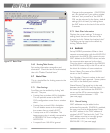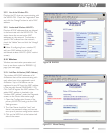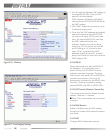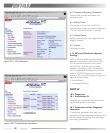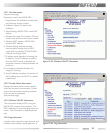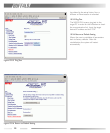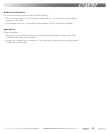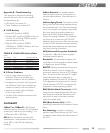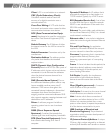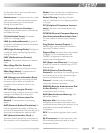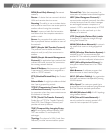
26
Client: A PC or a workstation on a network.
CRC (Cyclic Redundancy Check):
Calculation method used to check the
accuracy of a digital transmission over a
communications link.
Cross-Over Wiring: A UTP cable that has
its transmit and receive wires crossed to allow
communications between two devices.
DCE (Data Communications Equip-
ment): Hardware to be used for communica-
tion with a Data Terminal Equipment (DTE)
device
Default Gateway: The IP Address of either
the nearest router for the LAN or server for
the LAN.
Default Parameter: Parameters set by the
manufacturer.
Destination Address: The address portion
of a packet that identifies the intended
recipient station.
DHCP (Dynamic Host Configuration
Protocol): Based on BOOTP, it uses a pool of
IP addresses, which it gives out to each device
connected to it, and retrieves the addresses
when the devices become dormant for a
period of time.
DNS (Domain Name System): The on-
line distributed database system used to map
human-readable machine names into IP
addresses. DNS servers throughout the
connected Internet implement a hierarchical
namespace that allows sites freedom in
assigning machine names and addresses. DNS
also supports separate mappings between mail
destinations and IP addresses.
Driver: A software program that tells an
operating system how to use a hardware
device.
DSSS (Direct Sequence Spread
Spectrum): A method that spreads the
wireless signal into wide frequency bandwidth.
DTE (Data Terminal Equipment): Device
that controls data flowing to or from a
computer.
Dynamic IP Address: An IP address that is
automatically assigned to a client station in a
TCP/IP network, typically by a DHCP server.
ESS (Extended Service Set): A set of two
or more BSSs that form a single sub-network.
ESS-ID is user identification to be used in the
ESS LAN configuration.
Ethernet: The most widely used architecture
for Local Area Networks (LANs). It is a shared
media network architecture.
Ethernet cable: A wire similar to telephone
cable that carries the signals between Ethernet
devices.
File and Print Sharing: An application
supplied by Microsoft that allows the comput-
ers on a network to share files and printers.
Firmware: Programming that is inserted into
programmable read-only memory, thus
becoming a permanent part of a computing
device.
Frame: A frame includes: the data packet, the
destination device's address, source device's
address, the length of the data packet, and
error checking information.
Full-Duplex: Capability for simultaneous
transmission in both directions, allowing
devices to send & receive data at the same
time.
Gbps (Gigabits per second): A measure-
ment of billions of bits per second.
Half-duplex: To transmit on the same channel
in both directions, one direction at a time.
Hub: A device which allows connection of
computers and other devices to form a LAN.
When a hub receives packets from a com-
puter or other device, it repeats the packets to
all of the devices connected to its ports.
IEEE (Institute of Electrical and
Electronics Engineers): The professional
organization which promotes development of
electronics technology.
IP (Internet Protocol) Address: A unique
32-binary digit number assigned by an Internet
authority that identifies each sender or receiver



